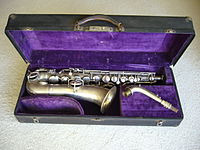Saxophone
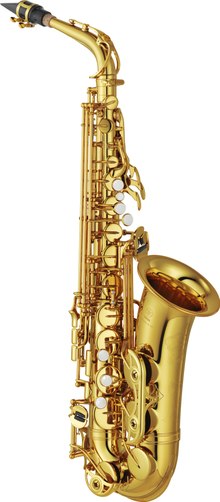 An alto saxophone | |
| Woodwind instrument | |
|---|---|
| Classification |
|
| Hornbostel–Sachs classification | 422.212-71 (Single-reeded aerophone with keys) |
| Inventor(s) | Adolphe Sax |
| Developed | 28 June 1846[1] |
| Playing range | |
 | |
| Related instruments | |
Military band family:
Orchestral family:
Other saxophones:
| |
| Musicians | |
| |
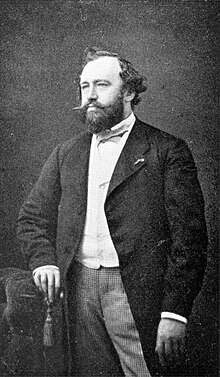
Adolphe Sax, the inventor of the saxophone
The saxophone (also referred to as the sax) is a family of woodwind instruments. Saxophones are usually made of brass and played with a single-reed mouthpiece similar to that of the clarinet.[2] Like the clarinet, saxophones have holes in the instrument which the player closes using a system of key mechanisms. When the player presses a key, a pad either covers a hole or lifts off a hole, lowering or raising the pitch, respectively.
The saxophone family was invented by the Belgian instrument maker Adolphe Sax in 1840.[2][3] Adolphe Sax wanted to create a group or series of instruments that would be the most powerful and vocal of the woodwinds, and the most adaptive of the brass instruments, that would fill the vacant middle ground between the two sections. Sax patented the saxophone on June 28, 1846, in two groups of seven instruments each. Each series consisted of instruments of various sizes in alternating transposition. The series pitched in B♭ and E♭, designed for military bands, have proved popular and most saxophones encountered today are from this series. Instruments from the so-called "orchestral" series, pitched in C and F, never gained a foothold, and the B♭ and E♭ instruments have now replaced the C and F instruments when the saxophone is used in an orchestra.
The saxophone is used in classical music (such as concert bands, chamber music, solo repertoire, and, occasionally, orchestras), military bands, marching bands, and jazz (such as big bands and jazz combos). The saxophone is also used as a soloing and melody instrument or as a member of a horn section in some styles of rock and roll and popular music. Saxophone players are called saxophonists.[2]
Contents
1 History
2 Description
2.1 Materials
2.2 Mouthpiece and reed
3 Saxophone family
4 Uses
4.1 In military bands and classical music
4.1.1 Selected works of the repertoire
4.1.2 Selected saxophone quartets
4.1.3 Selected orchestral pieces that include saxophones
4.2 In jazz and popular music
5 Unusual variants
6 Related instruments
7 Composition
8 Image gallery
9 Notes
10 References
11 External links
History
The saxophone was developed in 1846 by Adolphe Sax, a Belgian instrument maker, flautist, and clarinetist. Born in Dinant and originally based in Brussels, he moved to Paris in 1842 to establish his musical instrument business.
Prior to his work on the saxophone, he had made several improvements to the bass clarinet by improving its keywork and acoustics and extending its lower range. Sax was also a maker of the then-popular ophicleide, a large conical brass instrument in the bass register with keys similar to a woodwind instrument. His experience with these two instruments allowed him to develop the skills and technologies needed to make the first saxophones.
As an outgrowth of his work improving the bass clarinet, Sax began developing an instrument with the projection of a brass instrument and the agility of a woodwind. He wanted it to overblow at the octave, unlike the clarinet, which rises in pitch by a twelfth when overblown. An instrument that overblows at the octave has identical fingering for both registers.
Sax created an instrument with a single-reed mouthpiece like a clarinet, conical brass body like an ophicleide, and some acoustic properties of both the horn and the clarinet.[clarification needed]
Having constructed saxophones in several sizes in the early 1840s, Sax applied for, and received, a 15-year patent for the instrument on June 28, 1846.[4] The patent encompassed 14 versions of the fundamental design, split into two categories of seven instruments each, and ranging from sopranino to contrabass.
Although the instruments transposed at either F or C have been considered "orchestral", there is no evidence that Sax intended this. As only three percent of Sax's surviving production were pitched in F and C, and as contemporary composers used the E♭ alto and B♭ bass saxophone freely in orchestral music, it is almost certain that Sax experimented to find the most suitable keys for these instruments, settling upon instruments alternating between E♭ and B♭ rather than those pitched in F or C, for reasons of tone and economy (the saxophones were the most expensive wind instruments of their day). The C soprano saxophone was the only instrument to sound at concert pitch. All the instruments were given an initial written range from the B below the treble staff to the F, one space above the three ledger lines above staff, giving each saxophone a range of two and a half octaves.
Sax's patent expired in 1866;[5] thereafter, numerous saxophonists and instrument manufacturers implemented their own improvements to the design and keywork.
The first substantial modification was by a French manufacturer who extended the bell slightly and added an extra key to extend the range downwards by one semitone to B♭. It is suspected that Sax himself may have attempted this modification. This extension is now commonplace in almost all modern designs, along with other minor changes such as added keys for alternate fingerings. Using alternate fingerings allows a player to play faster and more easily. A player may also use alternate fingerings to bend the pitch. Some of the alternate fingerings are good for trilling, scales, and wide interval jumps.[6]
Sax's original keywork, which was based on the Triebert system 3 oboe for the left hand and the Boehm clarinet for the right, was simplistic and made playing some legato passages and wide intervals extremely difficult to finger, so numerous developers added extra keys and alternate fingerings to make chromatic playing less difficult.
While early saxophones had two separate octave vents to assist in the playing of the upper registers just as modern instruments do, players of Sax's original design had to operate these via two separate octave keys operated by the left thumb. A substantial advancement in saxophone keywork was the development of a method by which the left thumb operates both tone holes with a single octave key, which is now universal on modern saxophones.
The modern layout of the saxophone emerged during the 1930s and 1940s, first with right-side bell keys introduced by C. G. Conn on baritones, then by King on altos and tenors. The mechanics of the left hand cluster were revolutionized by Selmer with their balanced action instruments in 1936 and in 1948 Selmer introduced their Super Action saxophones with offset left and right hand stack keys. Between 30 and 40 years after Selmer devised their final layout it had been adopted for virtually every saxophone being produced, from student to professional models.[citation needed]
One of the most radical, however temporary, revisions of saxophone keywork was made in the 1950s by M. Houvenaghel of Paris, who completely redeveloped the mechanics of the system to allow a number of notes (C♯, B, A, G, F and E♭) to be flattened by a semitone simply by pressing the right middle finger. This enables a chromatic scale to be played over two octaves simply by playing the diatonic scale combined with alternately raising and lowering this one digit.[7] However, this keywork never gained much popularity, and is no longer in use.
Description
 Play media
Play mediaA man practices the saxophone in Yoyogi park
The saxophone consists of an approximately conical tube, usually of thin brass, flared at the tip to form a bell. At intervals along the tube are between 20 and 23 tone holes of varying size and two very small vent holes to assist the playing of the upper register. These holes are covered by keys (also known as pad cups) containing soft leather pads, which are closed to produce an airtight seal. At rest some of the holes stand open and others are closed.
The keys are activated by keytouches pressed by the fingers, either directly on the pad cup or connected to it with levers, either directly or with joints called "linkages." The right thumb sits under a thumb rest to stabilize and balance the saxophone, while the weight of most saxophones is supported by a neckstrap attached to a strap ring on the rear of the body of the instrument.
The fingering for the saxophone is a combination of that of the oboe with the Boehm system and is very similar to the flute or upper register of the clarinet. Instruments that play to low A have a left thumb key for that note.
The simplest design of saxophone is a straight conical tube, and the sopranino and soprano saxophones are usually of this design. However, as the lower-pitched instruments would be unacceptably long, they usually incorporate a U-bend ("bow") at or slightly above the third-lowest tone hole. As this would cause the bell to point almost directly upward, the end of the instrument is either beveled or tilted slightly forward. This U-shape has become a distinctive feature of the saxophone family, to the extent that soprano and even sopranino saxes are sometimes made in the curved style. By contrast, tenors and even baritones have occasionally been made in the straight style.[8][9]
Most commonly, however, the alto and tenor saxophones incorporate a detachable, curved "neck" above the highest tone hole directing the mouthpiece to the player's mouth while the instrument is held in a playing stance. The baritone, bass, and contrabass saxophones accommodate the length of the bore with extra bows and right-angle bends between the main body and the mouthpiece.
Materials
Although most saxophones are made from brass, they are categorized as woodwind instruments. This is because sound is produced by an oscillating wooden reed, not lips against a mouthpiece as in a brass instrument, and because pitches are produced by breath passing opening and closing keys. The screw pins that connect the rods to the posts, and the needle and leaf springs that cause the keys to return to their rest position after being released, are usually made of blued or stainless steel. Since 1920 most saxophones have "key touches", smooth replaceable pieces placed where the fingers touch the instrument, which are usually made from either plastic or mother of pearl. Some saxophones are made with abalone or stone key touches.[citation needed]
For visual and tonal effect, higher copper alloys are sometimes substituted for the more common "yellow brass" or "cartridge brass". Yanagisawa made its 902 and 992 series saxophones with phosphor bronze to achieve a darker, more "vintage" tone than the brass 901 and 991 models.[10] Other saxophones made of high copper alloys are sold under the brands Chateau, Kessler, Saxgourmet, and Bauhaus Walstein.
King introduced saxophones with necks and bells of sterling silver during the 1930s and continued that scheme into the early 1960s. Yanagisawa revived it during the 1980s and later introduced entire instruments of sterling silver.[11]Keilwerth and P. Mauriat have made saxophones with nickel silver bodies.[12]
Opinions vary on the significance of body materials to sound. With the exception of the identical brass and phosphor bronze Yanagisawa models, opportunities to isolate body materials from other variables in design and construction are lacking.[citation needed]
Other materials have been tried with varying degrees of success, such as the 1950s Grafton plastic alto saxophone and its successor, the Vibratosax, a polycarbonate model. Wooden Sawat saxophones are made in Thailand on a small scale.[citation needed]
Before final assembly, manufacturers usually apply a thin coating of clear or colored acrylic lacquer or silver plate over the brass. The lacquer or plating serves to protect the brass from oxidation and maintains its shiny appearance. Several different types and colors of surface finish have been used over the years.[13] It is also possible to plate the instrument with nickel or gold, and a number of gold-plated saxophones have been produced.[13] Plating saxophones with gold is an expensive process because gold does not adhere directly to brass. As a result, the brass is first plated with silver, then gold. Some saxophonists, sellers, and repair technicians argue that the type of lacquer or plating or absence thereof[14] may enhance an instrument's tone quality. The possible effects of different finishes on tone are difficult to isolate from other variables that affect an instrument's tone colors. In any case, what constitutes a pleasing tone is a matter of personal preference.
Mouthpiece and reed

A tenor sax mouthpiece
The saxophone uses a single-reed mouthpiece similar to that of the clarinet. Most saxophonists use reeds made from Arundo donax cane, but since the 20th century some have also been made of fiberglass and other composite materials.
Saxophone reeds are proportioned slightly differently from clarinet reeds, being wider for the same length, although some soprano saxophonists use clarinet reeds.[citation needed] Each size of saxophone (alto, tenor, etc.) uses a different size of reed. Reeds are commercially available in a vast array of brands, styles, and strengths. Saxophonists experiment with reeds of different strength (hardnesses) and material to find which strength and cut suits their mouthpiece, embouchure, physiology, and playing style.
The saxophone mouthpiece is larger than that of the clarinet, has a wider inner chamber, and lacks the cork-covered tenon because the saxophone neck inserts into the mouthpiece whereas the clarinet mouthpiece is inserted into the barrel. Saxophone and clarinet embouchures differ from each other in firmness, position of the lower lip, and range of entry angles. The "long tones" exercise is used to develop embouchure, along with airstream and breath control.[15]Mouthpieces come in a wide variety of materials, including vulcanized rubber (sometimes called hard rubber or ebonite), plastic, and metals such as bronze or surgical steel. Less common materials that have been used include wood, glass, crystal, porcelain, and even bone. According to Larry Teal, the mouthpiece material has little, if any, effect on the sound, and the physical dimensions give a mouthpiece its tone colour.[16] There are examples of "dark" sounding metal pieces and "bright" sounding hard rubber pieces – Marcel Mule, for example, used a metal mouthpiece to perform classical music.[17] Some[who?] contend that instability at the mouthpiece/neck connection moves harmonic frequencies off series with the fundamental frequency and each other, resulting in a "spread" sound, and that the weight of a metal mouthpiece counteracts that instability, increasing tonal "focus."
Mouthpiece design has a profound impact on tone. Early mouthpieces were designed to produce a warm and round sound for classical playing. Among classical mouthpieces, those with a concave ("excavated") chamber are more true to Adolphe Sax's original design; these provide a softer or less piercing tone favored by some saxophonists, including students of Sigurd Raschèr, for classical playing. Saxophonists who follow the French school of classical saxophone playing, influenced by Marcel Mule, generally use mouthpieces with smaller chambers than Rascher style mouthpieces. The use of the saxophone in dance orchestras and jazz ensembles put a premium on dynamic range, projection, and tonal richness, leading to rapid innovation in chamber shape and tip design, and metal construction. At the opposite extreme from the classical mouthpieces are those with a small chamber and a low clearance above the reed between the tip and the chamber, called high baffle. These produce a bright sound with maximum projection, suitable for having a sound stand out among amplified instruments and typical of modern pop and smooth jazz. Most saxophonists who play different styles have a mouthpiece suited for each style.[citation needed]
Saxophone family
The primary (military band) saxophone family alternates instruments in B♭ and E♭. The other (orchestral) family patented by Sax, alternating instruments in C and F, has always been marginal, although some manufacturers tried to popularise the soprano in C (C soprano saxophone), the alto in F (mezzo-soprano saxophone), and the tenor in C (C melody saxophone) early in the twentieth century. The C melody enjoyed some success in the late 1920s and early 1930s as a parlor instrument. One company has recently revived production of the C soprano and C melody.[18] Instruments in F are rare. A mezzo-soprano in G has also been produced.
| # | Saxophone | Key | Sounds an octave lower than | Sounds an octave higher than |
|---|---|---|---|---|
| 1 | Sopranissimo | B♭ | ## | Soprano |
| 2 | Sopranino | E♭ | ## | Alto |
| 3 | Soprano | B♭ | Sopranissimo | Tenor |
| 4 | Alto | E♭ | Sopranino | Baritone |
| 5 | Tenor | B♭ | Soprano | Bass |
| 6 | Baritone | E♭ | Alto | Contrabass |
| 7 | Bass | B♭ | Tenor | Subcontrabass |
| 8 | Contrabass | E♭ | Baritone | ## |
| 9 | Subcontrabass | B♭ | Bass | ## |
Uses
@media all and (max-width:720px).mw-parser-output .tmulti>.thumbinnerwidth:100%!important;max-width:none!important.mw-parser-output .tmulti .tsinglefloat:none!important;max-width:none!important;width:100%!important;text-align:center

In military bands and classical music
The saxophone first gained popularity in one of the uses it was designed for: military bands. Although the instrument was mostly ignored in Germany at first, French and Belgian military bands took full advantage of the instrument that Sax had designed. Most French and Belgian military bands incorporate at least a quartet of saxophones, comprising an E♭ baritone, B♭ tenor, E♭ alto and B♭ soprano. These four instruments have proved the most popular of all of Sax's creations, with the E♭ contrabass and B♭ bass usually considered impractically large and the E♭ sopranino insufficiently powerful. British military bands tend to include at minimum two saxophonists, on the alto and tenor. Today, the saxophone is used in military bands all around the world.[citation needed]
The saxophone was subsequently introduced into the concert bands, which generally call for an E♭ alto saxophone, a B♭ tenor saxophone, and an E♭ baritone saxophone. A typical high-level[clarification needed] concert band includes two altos, one tenor, and one baritone. A B♭ soprano saxophone is also occasionally used, in which case it is normally played by the first alto saxophonist. A bass saxophone in B♭ is called for in some concert band music (especially music by Percy Grainger).[19]
Saxophones are used in chamber music, such as saxophone quartets and other chamber combinations of instruments.
The classical saxophone quartet consists of a soprano saxophone, alto saxophone, tenor saxophone, and baritone saxophone. There is a repertoire of classical compositions and arrangements for the SATB instrumentation dating back to the nineteenth century, particularly by French composers who knew Sax. Classical saxophone quartets include Quatuor Habanera, the h2 quartet, the Raschèr Saxophone Quartet, the Aurelia Saxophone Quartet, the New Century Saxophone Quartet. The quartets led by Marcel Mule and Daniel Deffayet, saxophone professors at the Conservatoire de Paris, were started in 1928 and 1953, respectively, and were highly regarded. The Mule quartet is often considered the prototype for future quartets, due the level of virtuosity demonstrated by its members and its central role in the development of the quartet repertoire. However, organized quartets existed before Mule's ensemble, the prime example being the quartet headed by Eduard Lefebre (1834–1911), former soloist with the John Philip Sousa band in the United States c. 1904–1911. Other ensembles most likely existed at this time as part of the saxophone sections of the many touring professional bands that existed in the late 19th and early 20th centuries.[citation needed]
In the 20th and 21st centuries, the saxophone found increased popularity in symphony orchestras. In one or another size, the instrument has also been found as a useful accompaniment to genres such as opera and choral music. Many musical theatre scores include parts for a saxophone, sometimes doubling another woodwind or brass instrument. In this way, the saxophone serves as a middle point between other woodwinds and the brass section, helping to blend them.
Selected works of the repertoire
Fantasie sur un thème original (1860)—Jules Demersseman- Rapsodie pour orchestre et saxophone [Rhapsody for orchestra and saxophone] (1901)—Claude Debussy
Choral varié, Op.55 (1903)—Vincent d'Indy
Légende, Op.66 (1918)—Florent Schmitt- Saxophone Concerto (1934)—Lars-Erik Larsson
Concerto in E♭ major for alto saxophone and orchestra (1934)—Alexander Glazunov
Concertino da camera (1935)—Jacques Ibert
Aria pour saxophone alto (1936)—Eugène Bozza- Sonata for alto saxophone and piano (1937)—Bernhard Heiden
Scaramouche for alto saxophone and piano (1937)—Darius Milhaud- Ballade for Alto Saxophone (1938)—Henri Tomasi
- Sonata for alto saxophone and piano, Op. 19 (1939)—Paul Creston
- Sonata for alto saxophone and piano (1943)—Paul Hindemith
- Concerto for alto saxophone and orchestra, Op. 26 (1944)—Paul Creston
- Concerto for alto saxophone and orchestra (1948)—Ingolf Dahl
Fantasia for saxophone, three horns, and strings (1948)—Heitor Villa-Lobos- Concerto for alto saxophone and orchestra (1949)—Henri Tomasi
Tableaux de Provence (1955)—Paule Maurice
Prélude, cadence et finale (1956)—Alfred Desenclos- Saxophone Concerto (1958)—Erland von Koch
- Concerto for alto saxophone and orchestra (1959)—Pierre Max Dubois
Élégie et rondeau pour saxophone alto et orchestre (1961)—Karel Husa- Sonata for alto saxophone (1970)—Edison Denisov
- Sonata for alto saxophone and piano, Op. 29 (1970)—Robert Muczynski
- Concerto for Saxophone Quartet (1995)—Philip Glass[20][21]
- Concerto for Alto Saxophone and Orchestra (2013)—John Adams
Selected saxophone quartets
- Premier Quatuor [Quartet No. 1], Op. 53 (1857)—Jean-Baptiste Singelée
- Quartette [Quartet] (1879)—Caryl Florio
- Saxophone Quartet in B♭, Op.109 (1932)—Alexander Glazunov
Introduction et variations sur une ronde populaire (1934)—Gabriel Pierné
Andante et Scherzo for saxophone quartet (1938)—Eugène Bozza- Quatuor pour Saxophones [Quartet for Saxophones], Op. 102 (1939)—Florent Schmitt
Quatuor pour Saxophones (1956)—Pierre Max Dubois- Quatuor [Quartet] (1962)—Alfred Desenclos
- Suite for Saxophone Quartet (1979)—Paul Creston
XAS (1987)—Iannis Xenakis
Selected orchestral pieces that include saxophones
L'Arlésienne (1872) – Georges Bizet
Sylvia (1876) – Léo Delibes
Hérodiade (1881) – Jules Massenet
Werther (1892) – Jules Massenet
Symphonia Domestica (1904) – Richard Strauss
The Wooden Prince (1917) – Béla Bartók
Pictures at an Exhibition (1922 Ravel version) – Modest Mussorgsky/Maurice Ravel
Boléro (1928) – Maurice Ravel
La création du monde (1923) – Darius Milhaud
Symphony No. 4 (1924) – Charles Ives
Rhapsody in Blue (1924) – George Gershwin
An American in Paris (1928) – George Gershwin
Háry János (1926) – Zoltán Kodály
Turandot (1926) – Giacomo Puccini
Piano Concerto (1926) – Aaron Copland
Symphony No. 1 (1928) – Aaron Copland
Neues vom Tage (1929) – Paul Hindemith
Der Wein (1929) – Alban Berg
Violin Concerto (1935) – Alban Berg
Lulu (1937) – Alban Berg
The Golden Age (1930) – Dmitri Shostakovich
Suite No. 1 (1931) – Dmitri Shostakovich
Suite No. 2 (1938) – Dmitri Shostakovich
Suite for Variety Orchestra (post-1956) – Dmitri Shostakovich
Belshazzar's Feast (1931) – William Walton
Job: A Masque for Dancing (1931) – Ralph Vaughan Williams
Symphony No. 6 (1947) – Ralph Vaughan Williams
Symphony No. 9 (1957) – Ralph Vaughan Williams
Lieutenant Kijé (1934) – Sergei Prokofiev
Romeo and Juliet (1938) – Sergei Prokofiev
Alexander Nevsky (1938) – Sergei Prokofiev
Symphonic Dances (1940) – Sergei Rachmaninoff
Sinfonia da Requiem (1940) – Benjamin Britten
Billy Budd (1951) – Benjamin Britten
The Prince of the Pagodas (1957) – Benjamin Britten
On the Waterfront (1954) – Leonard Bernstein
West Side Story (1957) – Leonard Bernstein
City Noir (2009) – John Adams
In jazz and popular music
The saxophone is commonly used in jazz, where it is one of the signature sounds, as well as an iconic image to denote the style. Beginning in the early 20th century, saxophones became popular in dance bands. The use of saxophone as a jazz instrument is attributed to tenor saxophonist Coleman Hawkins when he was a member of the Fletcher Henderson Orchestra starting in 1923. The saxophone was soon embraced by Chicago-style musicians who added it, along with chordal instruments such as pianos, banjos, and guitars, to the trumpet-clarinet-trombone-bass-drums ensemble format inherited from New Orleans jazz.
The Duke Ellington Orchestra of the late 1920s featured saxophone-based ensembles and solos by Otto Hardwick, Johnny Hodges, and Harry Carney. The swing bands of the 1930s used arrangements of saxophone and brass sections playing off each other in call-response patterns. The influence of tenor saxophonist Lester Young with the Count Basie Orchestra in the late 1930s and the popularity of Hawkins' 1939 recording of "Body and Soul" marked the saxophone as an influence on jazz equal to that of the trumpet, which had been the defining instrument of jazz since its beginnings in New Orleans. But the greatest influence of the saxophone on jazz was to occur a few years later when alto saxophonist Charlie Parker became an icon of the bebop revolution that influenced generations of jazz musicians. The small-group format of bebop and post-bebop jazz ensembles, usually with one to three lead instruments including a saxophone, a chordal instrument, bass, and drums, gained ascendancy in the 1940s as musicians emphasized extended exploration, using the harmonic and melodic freedom pioneered by Parker, Dizzy Gillespie, Thelonious Monk, and Bud Powell.
The alto saxophone was also popularized in the 1950s by Sonny Stitt, Cannonball Adderley, Sonny Criss and Paul Desmond. The tenor sax was popularized by Lester Young, Coleman Hawkins, Dexter Gordon, John Coltrane, Sonny Rollins, Stan Getz, and Zoot Sims. The baritone sax, featured more in big bands (notably by Harry Carney in the Duke Ellington Orchestra) and larger ensembles than as a solo instrument, was popularized in jazz as a solo instrument within small groups by musicians such as Serge Chaloff, Gerry Mulligan, Pepper Adams and Leo Parker. The soprano saxophone was popularized by Sidney Bechet in early jazz, but then largely fell out of favor with greater emphasis on section playing during the 1930s. Steve Lacy renewed attention to the soprano in the context of modern jazz during the 1950s and John Coltrane boosted the instrument's popularity during the 1960s. Popular smooth jazz and contemporary pop musician Kenny G also uses the soprano sax as his principal instrument.
Saxophonists such as John Coltrane, Ornette Coleman, Sam Rivers, and Pharoah Sanders defined the forefront of creative exploration with the avant-garde movement of the 1960s. Modal, harmolodic, and free jazz further removed boundaries and the new space was explored with every device that saxophonists could conceive of. Sheets of sound, tonal exploration, upper harmonics, and multiphonics were hallmarks of the creative possibilities that saxophones offered in the new realm. One lasting influence of the avant-garde movement is the exploration of non-Western ethnic sounds on the saxophone, for example, the African-influenced sounds used by Sanders. The devices of the avant-garde movement have continued to be influential in music that challenges the boundaries between avant-garde and other categories of jazz, such as Steve Coleman and Greg Osby.
A jazz saxophone quartet is usually made up of one B♭ soprano, one E♭ alto, one B♭ tenor and one E♭ baritone (SATB). On occasion, the soprano is replaced with a second alto sax (AATB); a few professional saxophone quartets have featured non-standard instrumentation, such as James Fei's Alto Quartet[22] (four altos) and Hamiet Bluiett's Bluiett Baritone Nation (four baritones). Recently, the World Saxophone Quartet has become known as the preeminent jazz saxophone quartet.
The saxophone, as a solo instrument or as part of a horn section, can also be heard in blues, soul music, rhythm and blues, reggae, ska, funk, rock and roll, and other forms of popular music. Some players of these genres include King Curtis, Maceo Parker, Bobby Keys, Clarence Clemons, the Memphis Horns, and the Phenix Horns.
Unusual variants
A number of saxes and saxophone-related instruments have appeared since Sax's original work, most with no significant success. These include the saxello, essentially a straight B♭ soprano, but with a slightly curved neck and tipped bell; the straight alto; and the straight B♭ tenor.[23] Since a straight-bore tenor is approximately five feet long, the cumbersome size of such a design makes it almost impossible to either play or transport. "King" Saxellos, made by the H. N. White Company in the 1920s, now command prices up to US $4,000. A number of companies, including Keilwerth, Rampone & Cazzani (altello model), L.A. Sax and Sax Dakota USA, are marketing straight-bore, tipped-bell soprano saxophones as saxellos (or "saxello sopranos").
The contralto saxophone, similar in size to the orchestral soprano, was developed in the late 20th century by Californian instrument maker Jim Schmidt.[24] This instrument has a larger bore and a new fingering system, and does not resemble the C melody instrument except for its key and register. Another new arrival to the sax scene is the soprillo sax, a piccolo-sized straight instrument with the upper speaker hole built into the mouthpiece. The instrument, which extends Sax's original family, as it is pitched a full octave higher than the B♭ soprano sax, is manufactured by Benedikt Eppelsheim, of Munich, Germany. There is a rare prototype slide tenor saxophone. One company that produced a slide soprano saxophone was Reiffel & Husted, Chicago, c. 1922 (catalog NMM 5385).[25][26][27]
Two of these variants were championed by jazz musician Rahsaan Roland Kirk, who called his straight Buescher alto a "stritch" and his modified saxello a "manzello", the latter with an oversized bell and modified key work. Though rare, the Buescher straight alto was a production item instrument while the manzello was indeed a saxello with a custom-made bell.
Another unusual variant of the saxophone is the Conn-O-Sax, a straight-conical bore instrument in F (one step above the E♭ alto) with a slightly curved neck and spherical bell. This instrument, which combines a saxophone bore and keys with a bell shaped similar to that of a heckelphone, was intended to imitate the timbre of the English horn and was produced only in 1929 and 1930. The instrument has a key range from low A to high G. Fewer than 100 Conn-O-Saxes are in existence and they are highly sought by collectors. A mezzo-soprano in the key of G has been produced by Danish woodwind technician Peter Jessen, most notably played by Joe Lovano. This instrument is more in the timbral quality of Bb soprano saxophone.
The tubax, developed in 1999 by the German instrument maker Benedikt Eppelsheim,[28] plays the same range and with the same fingering as the E♭ contrabass saxophone; its bore, however, is narrower than that of a contrabass saxophone, making for a more compact instrument with a "reedier" tone (akin to the double-reed contrabass sarrusophone). It can be played with the smaller (and more commonly available) baritone saxophone mouthpiece and reeds. Eppelsheim has also produced subcontrabass tubaxes in C and B♭, the latter being the lowest saxophone ever made. Among the most recent developments is the aulochrome, a double soprano saxophone invented by Belgian instrument maker François Louis in 2001.
The fingering scheme of the saxophone, which has had only minor changes since the instrument's original invention, has presented inherent acoustic problems related to closed keys below the first open tonehole that affect response of, and slightly muffle, some notes. There is also a lack of tactile consistency moving between key centers. Extra effort is required from the player to adjust modes of muscle memory when moving between key centers. Two efforts to remedy the acoustic problems and awkward aspects of the original fingering system are noteworthy.
The Leblanc Rationale and System[29] saxophones have key mechanics designed to remedy the acoustic problems associated with closed keys below the first open tonehole. They also enable players to make half-step shifts of scales by depressing one key while keeping the rest of the fingering consistent with that of the fingering a half step away (which can also trip up players used to certain alternate fingerings on a regular saxophone). Some Leblanc System features were built into the Vito Model 35 saxophones of the 1950s and 1960s. The acceptance of what was arguably a superior system was impaired by the adjustment required of players switching between System and non-System horns, and the added costs associated with the compounded complexity of certain key mechanisms.
The chromatic or linear fingering, saxophone is a project of instrument designer and builder Jim Schmidt, developing a horn maximizing tactile and logical consistency between every interval regardless of the key, and avoiding the acoustic problems associated closed keys below the first open tone hole.[30] Several working prototypes have been built and presented at trade shows.[31] Production of this original and expensive saxophone is on an individual order basis.
Related instruments

Saxos de Bambú by Ángel Sampedro del Río, Argentina
Although not true saxophones, inexpensive keyless folk versions of the saxophone made of bamboo (recalling a chalumeau) were developed in the 20th century by instrument makers in Hawaii, Jamaica, Thailand, Indonesia, Ethiopia, and Argentina. The Hawaiian instrument, called a xaphoon, was invented during the 1970s and is also marketed as a "bamboo sax", although its cylindrical bore more closely resembles that of a clarinet, and its lack of any keywork makes it more akin to a recorder. Jamaica's best known exponent of a similar type of homemade bamboo "saxophone" was the mento musician and instrument maker 'Sugar Belly' (William Walker).[32] In the Minahasa region of the Indonesian island of Sulawesi, there exist entire bands made up of bamboo "saxophones"[33] and "brass" instruments of various sizes. These instruments are imitations of European instruments, made using local materials. Similar instruments are produced in Thailand.[34]
In Argentina, Ángel Sampedro del Río and Mariana García have produced bamboo saxophones of various sizes since 1985, the larger of which have bamboo keys to allow for the playing of lower notes.[35]
Composition




Music for most saxophones is usually notated using treble clef. The standard written range extends from a B♭ below the staff to an F or F♯ three ledger lines above the staff. Most, if not all, intermediate and professional saxophones made today are built with F♯ keys, with F♯ included on even student instruments.
There are many models of soprano saxophone that have a key for high G, and most modern models of baritone saxophone have an extended bore and key to produce low A; it is also possible to play a low A on any saxophone by blocking the end of the bell, usually with the foot or inside of the left thigh. Low A keys however were not limited to just the baritone saxophone. For a short time Selmer Paris produced mark VI alto saxophones with the low A key. Notes above F are considered part of the altissimo register of any sax, and can be produced using advanced embouchure techniques and fingering combinations. Sax himself had mastered these techniques; he demonstrated the instrument as having a range of just beyond three octaves up to a (written) high B4. Modern saxophone players have extended this range to over 4 octaves on tenor and alto.
Because all saxophones use the same key arrangement and fingering to produce a given notated pitch, it is not difficult for a competent player to switch among the various sizes when the music has been suitably transposed, and many do so. Since the baritone and alto are pitched in E♭, players can read concert pitch music notated in the bass clef by reading it as if it were treble clef and adding three sharps to the key signature. This process, referred to as clef substitution, makes it possible for the Eb instruments to play from parts written for baritone horn, bassoon, euphonium, string bass, trombone, or tuba. This can be useful if a band or orchestra lacks one of those instruments.
Image gallery
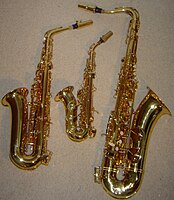
From left to right, an E♭ alto saxophone, a curved B♭ soprano saxophone, and a B♭ tenor saxophone
A straight-necked Conn C melody saxophone (Conn New Wonder Series 1)[36] with a serial number that dates manufacture to 1922
Vintage silver-plated 'Pennsylvania Special' alto saxophone, manufactured by Kohlert & Sons for Selmer[37] in Czechoslovakia, circa 1930
Conn 6M "Lady Face"[38] brass alto saxophone (dated 1935) in its original case
1950s Grafton alto made of plastic
Yamaha YAS-25 alto saxophone. Circa 1990s
Yanagisawa A9932J alto saxophone: has a solid silver bell and neck with solid phosphor bronze body. The bell, neck and key-cups are extensively engraved. Manufactured in 2008
Bauhaus Walstein tenor saxophone manufactured in 2008 from phosphor bronze
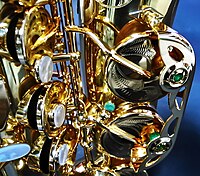
The lower portion of a P. Mauriat alto saxophone, showing the mother of pearl key touches and engraved brass pad cups

A Yamaha baritone saxophone

Two mouthpieces for tenor saxophone: the one on the left is ebonite; the one on the right is metal.
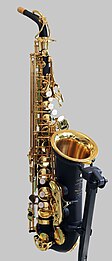
Ochres Music "No.5" hand-made professional alto saxophone with 24 carat gold seal on bell.
Notes
^ "June 28, 1846: Parisian Inventor Patents Saxophone". Wired.com. Retrieved 14 February 2011..mw-parser-output cite.citationfont-style:inherit.mw-parser-output qquotes:"""""""'""'".mw-parser-output code.cs1-codecolor:inherit;background:inherit;border:inherit;padding:inherit.mw-parser-output .cs1-lock-free abackground:url("//upload.wikimedia.org/wikipedia/commons/thumb/6/65/Lock-green.svg/9px-Lock-green.svg.png")no-repeat;background-position:right .1em center.mw-parser-output .cs1-lock-limited a,.mw-parser-output .cs1-lock-registration abackground:url("//upload.wikimedia.org/wikipedia/commons/thumb/d/d6/Lock-gray-alt-2.svg/9px-Lock-gray-alt-2.svg.png")no-repeat;background-position:right .1em center.mw-parser-output .cs1-lock-subscription abackground:url("//upload.wikimedia.org/wikipedia/commons/thumb/a/aa/Lock-red-alt-2.svg/9px-Lock-red-alt-2.svg.png")no-repeat;background-position:right .1em center.mw-parser-output .cs1-subscription,.mw-parser-output .cs1-registrationcolor:#555.mw-parser-output .cs1-subscription span,.mw-parser-output .cs1-registration spanborder-bottom:1px dotted;cursor:help.mw-parser-output .cs1-hidden-errordisplay:none;font-size:100%.mw-parser-output .cs1-visible-errorfont-size:100%.mw-parser-output .cs1-subscription,.mw-parser-output .cs1-registration,.mw-parser-output .cs1-formatfont-size:95%.mw-parser-output .cs1-kern-left,.mw-parser-output .cs1-kern-wl-leftpadding-left:0.2em.mw-parser-output .cs1-kern-right,.mw-parser-output .cs1-kern-wl-rightpadding-right:0.2em
^ abc "Saxophone". The Free Dictionary By Farlex. Retrieved 2012-05-25.
^ Raumberger, Ventzke, Claus, Karl. "Saxophone". Oxford Music Online. Retrieved 20 October 2013.
^ "Adolphe Sax". BassSax.com. Retrieved 2007-05-07.
^ "The history, of the saxophone". The-Saxophone.com. Retrieved 2008-01-06.
^ Thomas, Pete. "Taming the Saxophone".
^ MacGillivray, James (May 1959). "Recent Advances in Woodwind Fingering Systems". The Galpin Society Journal. The Galpin Society Journal. 12: 68. doi:10.2307/841949. JSTOR 841949.
^ "Jay C. Easton: Saxophone Family Gallery". Retrieved 2007-05-07.
^ "Contrabass-L, Vol. 1, No. 76". Retrieved 2007-05-07.
^ "Yanagisawa Saxophones". Web.archive.org. Archived from the original on June 16, 2009. Retrieved 2014-05-19.
^ "T9937". Yanagisawa website. Archived from the original on 2007-12-30. Retrieved 2008-01-06.
^ "PMST-60NS". Paul Mauriat website. Archived from the original on December 8, 2008. Retrieved 2008-08-22.
^ ab "The Horn". JazzBariSax.com.
^ "Saxophone questions from our friends & clients...CyberSax Tech Topics...Vintage & Pro Saxophones". cybersax.com. Archived from the original on 18 January 2012.
^ "Saxophone Embouchure and Saxophone Muscles – Learning Saxophone". Retrieved 2010-01-31.
^ Teal, Larry (1963). The Art of Saxophone Playing. Miami: Summy-Birchard. p. 17. ISBN 0-87487-057-7.A preference as to material used is up to the individual, and the advantages of each are a matter of controversy. Mouthpieces of various materials with the same dimensions, including the chamber and outside measurements as well as the facing, play very nearly the same.
^ Rousseau, Eugene. "Discussions". EugeneRousseau.com. The Art of Choosing a Saxophone Mouthpiece. Archived from the original on 2016-04-05. Retrieved 27 April 2016.
^ AquilaSax operates from New Zealand and manufactures in China.
^ Ventry, J. (26 March 1930). "A Talk On Modern Band Music". Trove.nla.gov.au. The Mercury. Retrieved 3 February 2017.
^ "Recommended Saxophone Repertoire Alto Saxophone Level III" (PDF). Music.indiana.edu.
^ Steven Mauk. "Selected Repertoire". Ithaca.edu. Retrieved 2014-05-19.
^ "James Fei: DVD". Archived from the original on 2006-12-17. Retrieved 2007-05-07.
^ "L.A. Sax Straight Models". Retrieved 2007-05-07.
^ "Jim Schmidt's Contralto". Archived from the original on April 8, 2007. Retrieved 2007-05-07.
^ "The Royal Holland Bell Ringers Collection and Archive". Retrieved 2006-10-23.
^ "Slide sax picture". Retrieved 2006-10-23.
^ "Slide sax picture". Archived from the original on 2007-06-28. Retrieved 2006-10-23.
^ "Tubax E♭ saxophone". Benedikt Eppelsheim Wind Instruments. Retrieved 2007-05-07.
^ "The Fabulous Leblanc Saxophones". saxgourmet.com.
^ "Saxophones with Linear Fingering System – Flutes and Saxes – JSengineering". jsengineering.net.
^ "Jim Schmidt demonstrates his unique saxophone". YouTube. 20 January 2009.
^ "Mento Music: Sugar Belly". Retrieved 2007-05-07.
^ "Culture & Arts in North Sulawesi, Indonesia". Archived from the original on 2007-04-02. Retrieved 2007-05-07.
^ "A bio-aesthetic offspring of single reed woodwinds-Dieter Clermont and his Thai partner Khanung Thuanthee build bamboo saxophones in North Thailand since the late 1980s". Archived from the original on 2008-09-21. Retrieved 2008-07-31.
^ "Un Mundo de Bambú". Retrieved 2007-05-07.
^ "Photo Gallery :: SaxPics.com". saxpics.com.
^ "Photo Gallery". SaxPics.com. Retrieved 2014-05-19.
^ "Photo Gallery :: SaxPics.com". saxpics.com.
References
.mw-parser-output .refbeginfont-size:90%;margin-bottom:0.5em.mw-parser-output .refbegin-hanging-indents>ullist-style-type:none;margin-left:0.mw-parser-output .refbegin-hanging-indents>ul>li,.mw-parser-output .refbegin-hanging-indents>dl>ddmargin-left:0;padding-left:3.2em;text-indent:-3.2em;list-style:none.mw-parser-output .refbegin-100font-size:100%
Grove, George (January 2001). Stanley Sadie, ed. The New Grove Encyclopædia of Music and Musicians (2nd ed.). Grove's Dictionaries of Music. Volume 18, pp534–539. ISBN 1-56159-239-0.
Horwood, Wally (1992) [1983]. Adolphe Sax, 1814–1894: His Life and Legacy ((Revised edition) ed.). Herts: Egon Publishers. ISBN 0-905858-18-2.
Howe, Robert (2003). Invention and Development of the Saxophone 1840–55. Journal of the American Musical Instrument Society.
Ingham, Richard (1998). The Cambridge Companion to the Saxophone. Cambridge Companions to Music. Cambridge: Cambridge Univ. Press. ISBN 0-521-59348-4.
Kool, Jaap (1931). Das Saxophon (in German). Leipzig: J. J. Weber. (translated to English as Gwozdz, Lawrence (1987). The Saxophone. Egon Publishers Ltd.)
Kotchnitsky, Léon (1985) [1949]. Sax and His Saxophone (Fourth ed.). North American Saxophone Alliance.
Lindemeyer, Paul (1996). Celebrating the Saxophone. William Morrow & Co. ISBN 0-688-13518-8.
Marzi, Mario (2009). Il Saxofono. The Expression of Music 4 (in Italian). Varese, Italy: Zecchini Editore (Zecchini Publisher). p. 468. ISBN 978-88-87203-86-8.
Segell, Michael (2005). The Devil's Horn: The Story of the Saxophone, from Noisy Novelty to King of Cool. Farrar, Straus and Giroux. ISBN 0-374-15938-6.
Thiollet, Jean-Pierre (2004). Sax, Mule & Co. Paris: H & D. ISBN 2-914266-03-0.
External links
Instruments In Depth: The Saxophone An online feature with video demonstrations from Bloomingdale School of Music (June 2009)- Saxophone Fingering Charts

